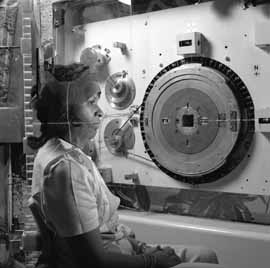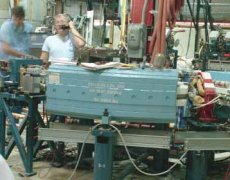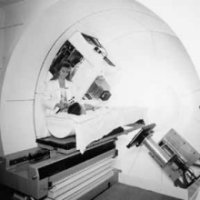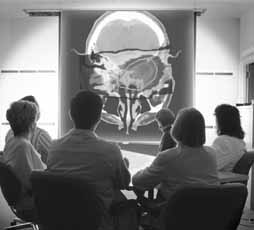iscoveries in physics have helped forge dramatic advances in cancer treatment for over a century. In 1950-54, according to the National Cancer Institute, the five-year survival rate for all cancers was 35 percent; by 2000 it was 59 percent. With early detection and treatment, the five-year survival rate for screenable cancers is now 80 percent.
When Ernest Lawrence and his brother John, a physician, treated their mother's cancer with neutrons in 1938, they were taking a new path just as others had with other forms of radiation. Within months of the discovery of X-rays in late 1895, therapists began treating countless ailments with Wilhelm Roentgen's "new light." By January of 1896, Emil Grubbe in Chicago was already treating two cancer patients. By trade, Grubbe was an electrician and metallurgist.
Now, accelerators producing X-rays and electrons for radiation therapy can be found at virtually every major medical center in the U.S. planned and operated by medical physicists, with treatment administered by radiation oncologists. Once an experiment, then a treatment of last resort, radiation therapy has evolved into the treatment of choice for many cancers. Particle accelerators have an integral role in today's cancer therapy.
 Fermilab's Neutron Therapy Facility has the highest energy and the deepest penetration of any fast neutron beam in the United States. Fast-moving neutrons are effective against large tumors. Chicago-area radiation oncologists Lionel Cohen and Frank Hendrickson worked with Fermilab Director Robert R. Wilson to build the Neutron Therapy Facility. Cohen served as the first NTF director, and the first patients were treated on September 7, 1976. More than 3,100 patients have been treated in 25 years.
Fermilab's Neutron Therapy Facility has the highest energy and the deepest penetration of any fast neutron beam in the United States. Fast-moving neutrons are effective against large tumors. Chicago-area radiation oncologists Lionel Cohen and Frank Hendrickson worked with Fermilab Director Robert R. Wilson to build the Neutron Therapy Facility. Cohen served as the first NTF director, and the first patients were treated on September 7, 1976. More than 3,100 patients have been treated in 25 years.
 Robert R.Wilson, Fermilab's founding director, first proposed using protons for cancer therapyin a 1946 paper, "Radiological Use of Fast Protons" (Radiology 47:487-491, 1946). Wilson, then at Harvard's Research Laboratory of Physics, wrote: "The range of a 125 MeV proton in tissue is 12 cm., while that of a 200 MeV proton is 27 cm. It is clear that such protons can penetrate to any part of the body."
Robert R.Wilson, Fermilab's founding director, first proposed using protons for cancer therapyin a 1946 paper, "Radiological Use of Fast Protons" (Radiology 47:487-491, 1946). Wilson, then at Harvard's Research Laboratory of Physics, wrote: "The range of a 125 MeV proton in tissue is 12 cm., while that of a 200 MeV proton is 27 cm. It is clear that such protons can penetrate to any part of the body."
 One of Fermilab's first employees, Don Young, helped plan and build the Neutron Therapy Facility. When he was diagnosed with prostate cancer in October 2000, he chose neutron therapy over surgery. "Knowing and understanding the neutron treatment method, the facility at Fermilab, the people here and the number of patients they've treated, it was an easy decision to make," he said.
One of Fermilab's first employees, Don Young, helped plan and build the Neutron Therapy Facility. When he was diagnosed with prostate cancer in October 2000, he chose neutron therapy over surgery. "Knowing and understanding the neutron treatment method, the facility at Fermilab, the people here and the number of patients they've treated, it was an easy decision to make," he said.
 The proton accelerator for Loma Linda University Medical Center in California was assembled and tested at Fermilab, then dismantled and shipped to Loma Linda.
The proton accelerator for Loma Linda University Medical Center in California was assembled and tested at Fermilab, then dismantled and shipped to Loma Linda.
 Loma Linda University Medical Center uses the world's first proton accelerator built specifically to administer proton therapy in a medical environment. The synchrotron accelerator was built at Fermilab and shipped to Loma Linda, where the first patients were treated in 1990. Since then, more than 6,000 patients have been treated. Loma Linda researchers are now intensifying their efforts to apply proton therapy to breast cancer.
Loma Linda University Medical Center uses the world's first proton accelerator built specifically to administer proton therapy in a medical environment. The synchrotron accelerator was built at Fermilab and shipped to Loma Linda, where the first patients were treated in 1990. Since then, more than 6,000 patients have been treated. Loma Linda researchers are now intensifying their efforts to apply proton therapy to breast cancer.

 Discoveries in physics have helped forge dramatic advances in cancer treatment for over a century. In 1950-54, according to the National Cancer Institute, the five-year survival rate for all cancers was 35 percent; by 2000 it was 59 percent. With early detection and treatment, the five-year survival rate for screenable cancers is now 80 percent.
Discoveries in physics have helped forge dramatic advances in cancer treatment for over a century. In 1950-54, according to the National Cancer Institute, the five-year survival rate for all cancers was 35 percent; by 2000 it was 59 percent. With early detection and treatment, the five-year survival rate for screenable cancers is now 80 percent.
 Fermilab's Neutron Therapy Facility has the highest energy and the deepest penetration of any fast neutron beam in the United States. Fast-moving neutrons are effective against large tumors. Chicago-area radiation oncologists Lionel Cohen and Frank Hendrickson worked with Fermilab Director Robert R. Wilson to build the Neutron Therapy Facility. Cohen served as the first NTF director, and the first patients were treated on September 7, 1976. More than 3,100 patients have been treated in 25 years.
Fermilab's Neutron Therapy Facility has the highest energy and the deepest penetration of any fast neutron beam in the United States. Fast-moving neutrons are effective against large tumors. Chicago-area radiation oncologists Lionel Cohen and Frank Hendrickson worked with Fermilab Director Robert R. Wilson to build the Neutron Therapy Facility. Cohen served as the first NTF director, and the first patients were treated on September 7, 1976. More than 3,100 patients have been treated in 25 years.
 Robert R.Wilson, Fermilab's founding director, first proposed using protons for cancer therapyin a 1946 paper, "Radiological Use of Fast Protons" (Radiology 47:487-491, 1946). Wilson, then at Harvard's Research Laboratory of Physics, wrote: "The range of a 125 MeV proton in tissue is 12 cm., while that of a 200 MeV proton is 27 cm. It is clear that such protons can penetrate to any part of the body."
Robert R.Wilson, Fermilab's founding director, first proposed using protons for cancer therapyin a 1946 paper, "Radiological Use of Fast Protons" (Radiology 47:487-491, 1946). Wilson, then at Harvard's Research Laboratory of Physics, wrote: "The range of a 125 MeV proton in tissue is 12 cm., while that of a 200 MeV proton is 27 cm. It is clear that such protons can penetrate to any part of the body."
 One of Fermilab's first employees, Don Young, helped plan and build the Neutron Therapy Facility. When he was diagnosed with prostate cancer in October 2000, he chose neutron therapy over surgery. "Knowing and understanding the neutron treatment method, the facility at Fermilab, the people here and the number of patients they've treated, it was an easy decision to make," he said.
One of Fermilab's first employees, Don Young, helped plan and build the Neutron Therapy Facility. When he was diagnosed with prostate cancer in October 2000, he chose neutron therapy over surgery. "Knowing and understanding the neutron treatment method, the facility at Fermilab, the people here and the number of patients they've treated, it was an easy decision to make," he said.
 The proton accelerator for Loma Linda University Medical Center in California was assembled and tested at Fermilab, then dismantled and shipped to Loma Linda.
The proton accelerator for Loma Linda University Medical Center in California was assembled and tested at Fermilab, then dismantled and shipped to Loma Linda.
 Loma Linda University Medical Center uses the world's first proton accelerator built specifically to administer proton therapy in a medical environment. The synchrotron accelerator was built at Fermilab and shipped to Loma Linda, where the first patients were treated in 1990. Since then, more than 6,000 patients have been treated. Loma Linda researchers are now intensifying their efforts to apply proton therapy to breast cancer.
Loma Linda University Medical Center uses the world's first proton accelerator built specifically to administer proton therapy in a medical environment. The synchrotron accelerator was built at Fermilab and shipped to Loma Linda, where the first patients were treated in 1990. Since then, more than 6,000 patients have been treated. Loma Linda researchers are now intensifying their efforts to apply proton therapy to breast cancer.